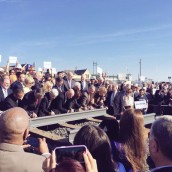Marking significant progress toward modernizing, on 6th January California’s transportation infrastructure, the California High-Speed Rail Authority, joined hundreds of supporters and government, student, community, transportation, business and labor leaders to break ground on the nation’s first high-speed rail system in Fresno. “What is important is the connection that we are rooted in our forebears and we are committed and linked to our descendants” – said Governor Edmund G. Brown Jr. at a ceremony held at the site of the future high-speed rail station in downtown Fresno. “And the high-speed rail links us from the past to the future, from the south to Fresno and north; this is truly a California project bringing us together today”. In addition to the support of federal, state and local dignitaries, there was strong backing from Central Valley and California-based construction crews, small businesses, and local students who were eager to highlight how high-speed rail is positively affecting California today and will continue to into the future. “We now enter a period of sustained construction on the nation’s first high-speed rail system – for the next five years in the Central Valley and for a decade after that across California” – said High-Speed Rail Authority Board of Directors Chairman Dan Richard. “This is an investment that will forever improve the way Californians commute, travel, and live. And today is also a celebration of the renewed spirit that built California”. The ceremony included remarks from owners of a family-owned steel manufacturer already benefitting from high-speed rail construction. Student leaders from Fresno State and University of California, Merced also explained how high-speed rail is creating new local opportunities. Although today represented the official groundbreaking ceremony, the event also showcased ground that has already been broken in the Central Valley. The Authority provided tours of nearby construction activity, including various demolition sites. Other achievements to date include finalization of project designs, ongoing right-of-way purchases, and workforce training and mobilization. Local and statewide small businesses are completing a majority of this work. As of September 2014, 40 small businesses have active contracts valued at $296 million on Construction Package 1, a 29-mile stretch from Avenue 17 in Madera County to East American Avenue in Fresno County. This phase of construction includes 12 grade separations, two viaducts, a tunnel, and a bridge over the San Joaquin River. California-based Tutor Perini Zachry/Parsons (TPZP), A Joint Venture, is designing and building this first phase of the project.
